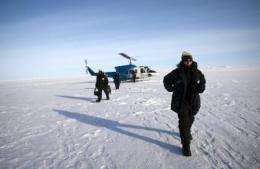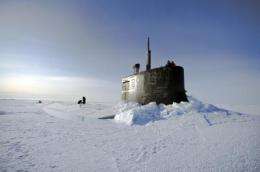Office of Naval Research supports exercise at Arctic test range

From collecting data on the environment to testing undersea communications, Ice Exercise 2011 (ICEX 2011), which runs March 15 through April 2, includes several Office of Naval Research (ONR) projects designed to improve naval operations in the Arctic.
ICEX is held every two to three years by the Navy's Arctic Submarine Laboratory (ASL) based in San Diego. Researchers and submariners are deployed to the frigid region to test new equipment and train crews in operating under the ice.
During the first few days of the exercise, ONR's Chief of Naval Research Rear Adm. Nevin Carr visited the ICEX operations center and spent time aboard USS Connecticut (SSN 22), the advanced Seawolf-class submarine that is participating in this year's exercise. In addition to Connecticut, USS New Hampshire (SSN 778) is testing a new version of a high-frequency sonar for safe Arctic operations,
"It is vital that our submarines are well equipped to protect U.S. interests in this important area," Carr said. "ONR is collaborating with the good work of the Arctic Submarine Lab to conduct science and technology experiments that help improve navigation, communication and naval operations in the harsh Arctic environment."

Submarines have conducted under-ice research since the 1950s to provide the U.S. Navy with an improved forecast capability for changing conditions in the Arctic. By comparing satellite, airborne, surface and subsurface sonar observations, researchers have improved interfleet transit, training and cooperative allied engagements.
For this year's exercise, ONR is sponsoring several projects to measure sea ice thickness and snow depth, said Cmdr. Daniel Eleuterio, ONR's director of Ocean Battlespace Sensing and Applications Division. In addition, ONR is supporting students from the Naval Postgraduate School, who are researching the characteristics of a pressure ridge keel as part of ICEX. Ice keels are the submerged counterparts of ice ridges and can pose a hazard to submarines.
The collaborative research includes the U.S. Army Cold Regions Research and Engineering Laboratory and Naval Research Laboratory's ground and airborne measurements of the Arctic ice thickness.
ONR is also backing a program where ASL personnel aboard the submarine will deploy Expendable Conductivity Temperature Depth (XCTD) probes to study the salinity and temperature of the upper 1,000 meters of the water column. The XCTD program is anticipated to become a routine feature of future Scientific Ice Expeditions Science Accommodation Missions.
Provided by Office of Naval Research
















